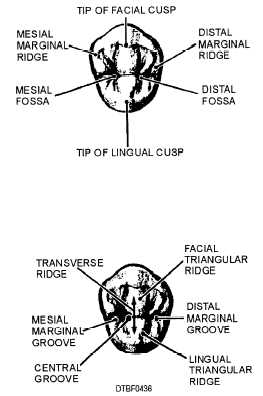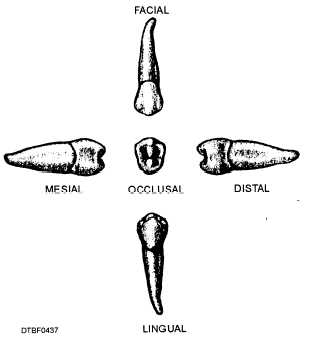
Figure 4-36. - Features of an occlusal surface of maxillary first bicuspid.
cusps.") Sometimes bicuspids are called
premolars because they are just in front of the molar teeth.
Facial Surface - The facial surface is somewhat similar to the facial surface of the cuspid.
However, the tip of the facial cusp is located in the center of the "biting" edge, which is called the occlusal edge or occlusal margin.
From the cusp tip to the cervical margin, there is a slight ridge, called the facial ridge, similar to the facial ridge found in cuspid teeth.
Lingual Surface - The lingual surface is narrower and shorter than the facial surface, and is smoothly convex in all directions.
The cusp tip is in the middle of the occlusal edge.
Root Surface - The root is quite flat on the mesial and distal surfaces.
In about 50 percent of maxillary first bicuspids, the root is divided in the apical third, and when it so divided, the tips of the facial and lingual roots are slender and finely tapered.
Occlusal Surface - The occlusal surface (fig. 4-36) has a facial cusp and a lingual cusp. There are mesial and distal marginal ridges.
Two fossae are on the occlusal surface-the mesial and distal fossae.
MAXILLARY SECOND BICUSPID
The maxillary second bicuspid (tooth #4 or #13), illustrated in figure 4-37, resembles the first bicuspid very closely, but is smaller in dimensions.
The cusps are not as sharp as the maxillary first bicuspid and have only one root.
MANDIBULAR FIRST BICUSPID
The mandibular first bicuspid (tooth #21 or #28), illustrated in figure 4-38, is the fourth tooth from the midline.
It is the smallest of the four bicuspids. The term
bell-crowned is used to describe its appearance. The mandibular first bicuspid has many characteristics of a cuspid.
Occlusal Surface - A large facial cusp, which is long and well defined, and a small nonfunctional lingual cusp are present on the mandibular first bicuspid.
Root Surface - The root of the mandibular first bicuspid is usually single, but on occasion can be bifurcated (two roots).
MANDIBULAR SECOND BICUSPID
The mandibular second bicuspid (tooth #20 or #29), illustrated in figure 4-39, is the fifth tooth from the midline.

Figure 4-37.—Surfaces of maxillary second bicuspid.
Continue Reading
